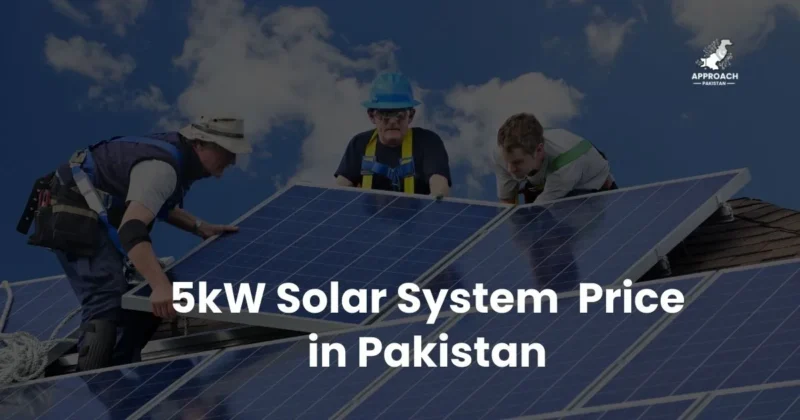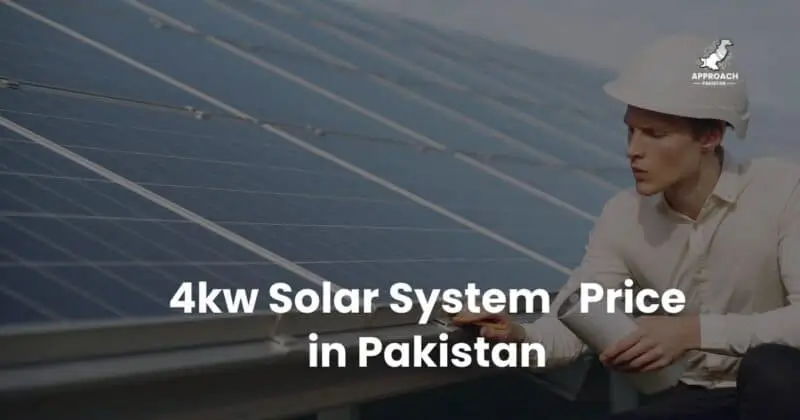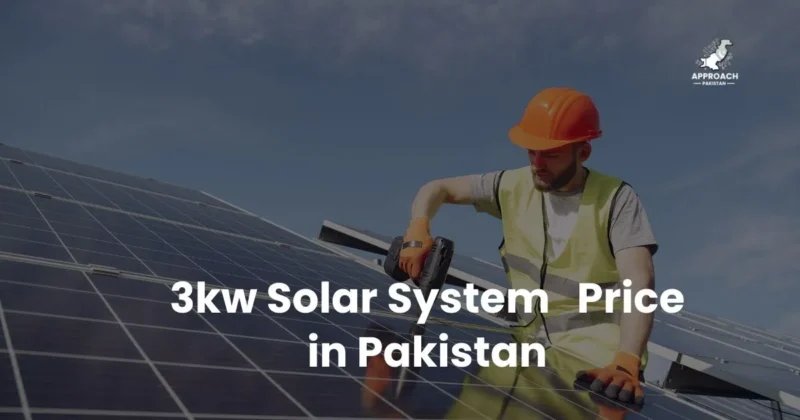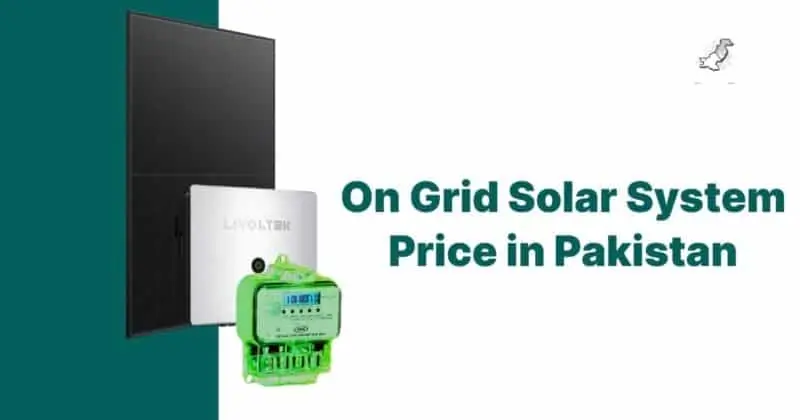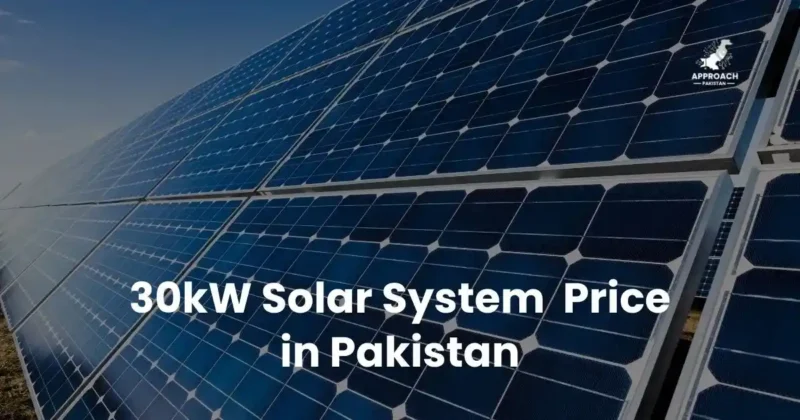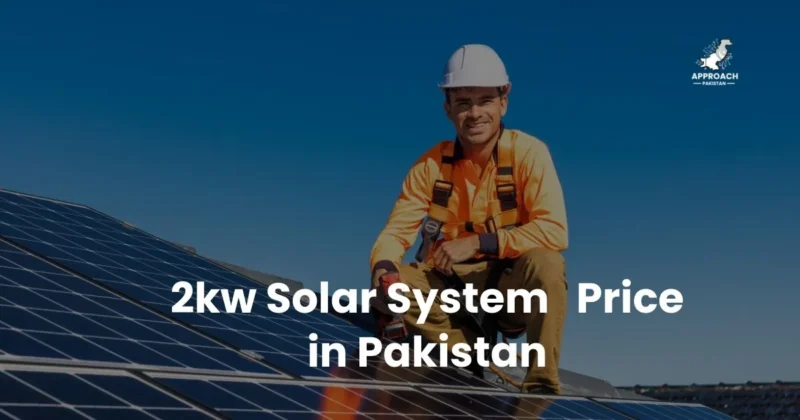35kW Solar Price in Pakistan | Complete Cost Analysis 2025
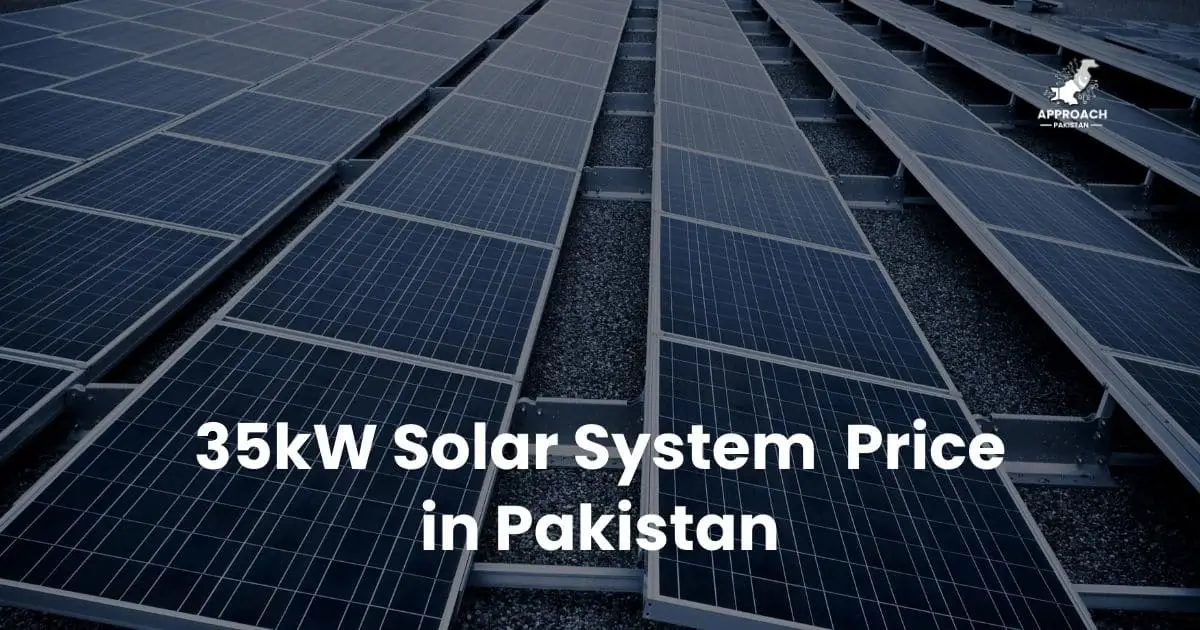
A 35kW solar system in Pakistan costs between PKR 2,800,000 to PKR 4,200,000 depending on system type and components. On-grid systems start from PKR 2,800,000, hybrid systems range PKR 3,500,000-4,200,000, while off-grid systems cost PKR 3,800,000-4,500,000 including batteries and installation.
Introduction to 35kW Solar Systems
High electricity bills eating away your monthly budget? You’re not alone.
Pakistani businesses and large households face the same crushing utility costs. Add frequent power outages to the mix, and you’ve got a recipe for frustration.
That’s where a 35kW solar system steps in. It’s your ticket to slashing electricity bills by 70-80% while gaining energy independence from Pakistan’s unreliable grid power.
What is a 35kW Solar System?
A 35kW solar system generates 35 kilowatts of electricity at peak conditions. Think of it as your personal power plant on the rooftop.
This system typically includes 100-140 solar panels, depending on panel wattage. It’s designed for commercial buildings, large homes, or small industrial operations.
The “35kW” refers to the system’s maximum power output under ideal sunlight conditions.
Who Should Consider a 35kW System?
Commercial establishments with monthly bills exceeding PKR 80,000 benefit most. Large residences, small factories, and agricultural operations also fit perfectly.
If you’re running multiple air conditioners, heavy machinery, or commercial equipment, 35kW provides the power capacity you need. It’s also ideal for businesses looking to reduce operational costs significantly.
Energy Generation Capacity Overview
A 35kW system generates approximately 140-175 kWh daily in Pakistan’s climate. That translates to 4,200-5,250 kWh monthly under average conditions.
Peak performance occurs during March-May when sunlight intensity is highest. Monsoon season (July-September) sees 15-20% reduced output due to cloud cover.
Your system’s actual performance depends on location, panel orientation, and local weather patterns.
35kW Solar System Pricing Analysis
Current Market Prices
On-Grid 35kW Systems:
- Basic tier: PKR 2,800,000 – 3,200,000
- Premium tier: PKR 3,200,000 – 3,600,000
Hybrid 35kW Systems:
- Standard setup: PKR 3,500,000 – 3,900,000
- Advanced configuration: PKR 3,900,000 – 4,200,000
Off-Grid 35kW Systems:
- Minimum battery backup: PKR 3,800,000 – 4,100,000
- Extended backup: PKR 4,100,000 – 4,500,000
Cost Breakdown by Components
Solar Panels (40-45% of total cost):
- Tier 1 panels: PKR 35-45 per watt
- Local brands: PKR 25-35 per watt
Inverters (15-20% of total cost):
- String inverters: PKR 15-25 per watt
- Power optimizers: PKR 25-35 per watt
Mounting Structure (8-12%):
- Galvanized steel: PKR 12-18 per watt
- Aluminum systems: PKR 18-25 per watt
Installation & Accessories (15-20%):
- Professional installation: PKR 8-15 per watt
- Electrical components: PKR 5-10 per watt
On-Grid vs Off-Grid vs Hybrid Pricing
On-grid systems cost least because they skip expensive batteries. You save PKR 800,000-1,200,000 compared to hybrid alternatives.
Hybrid systems add battery backup for power outages. This convenience costs extra but provides peace of mind during grid failures.
Off-grid systems cost most due to larger battery banks. They’re perfect for remote locations without grid access.
Financing Options and Government Incentives
State Bank of Pakistan Green Finance:
- Up to 85% financing
- 5-7 year repayment terms
- Competitive interest rates
Net Metering Benefits:
- Sell excess power to grid
- Monthly credit adjustments
- Zero additional equipment needed
AEDB Incentives:
- Accelerated depreciation benefits
- Import duty exemptions
- Tax credits available
Technical Specifications & Components of 30kW Solar System
Solar Panel Requirements (Quantity & Types)
Panel Quantity Options:
- 100 panels x 350W = 35kW
- 117 panels x 300W = 35.1kW
- 88 panels x 400W = 35.2kW
Recommended Panel Types: Monocrystalline panels perform best in Pakistan’s climate. They handle high temperatures better than polycrystalline alternatives.
Bifacial panels boost output by 10-15% but cost 20-30% more. They’re worth considering for commercial installations.
Inverter Selection Guide
String Inverter Setup:
- Single 35kW three-phase inverter
- Cost-effective for simple installations
- Easier maintenance and monitoring
Power Optimizer Configuration:
- Multiple smaller inverters with optimizers
- Better performance in partial shading
- Higher initial cost but superior reliability
Microinverter Option:
- Individual panel-level conversion
- Maximum power harvest potential
- Premium pricing for premium performance
Battery Storage Options (Hybrid/Off-Grid)
Lithium Iron Phosphate (LiFePO4):
- 10-15 year lifespan
- 90-95% efficiency
- Higher upfront cost
Lead Acid Batteries:
- 3-5 year lifespan
- 80-85% efficiency
- Lower initial investment
Battery Bank Sizing:
- Critical load backup: 50-75 kWhring monsoon season.
- Minimum backup: 100-150 kWh
- Extended backup: 200-300 kWh
35kW System Types Comparison
35kW On-Grid Solar System
On-grid systems connect directly to your utility grid. They’re the most economical choice for businesses with reliable grid access.
Key Benefits:
- Lowest installation cost
- Net metering earnings potential
- Minimal maintenance requirements
Best For:
- Commercial buildings with consistent grid power
- Businesses focused on cost reduction
- Locations with stable utility infrastructure
35kW Off-Grid Solar System
Off-grid systems operate independently from utility power. They’re perfect for remote locations or complete energy independence goals.
Key Features:
- Total grid independence
- Large battery storage capacity
- Backup generator compatibility
Ideal Applications:
- Remote industrial facilities
- Agricultural operations
- Areas with unreliable grid power
35kW Hybrid Solar System
Hybrid systems combine grid connection with battery backup. You get the best of both worlds – savings and security.
Primary Advantages:
- Power during outages
- Net metering benefits
- Load shifting capabilities
Perfect For:
- Critical operations requiring backup power
- Businesses wanting maximum flexibility
- Locations with intermittent grid issues
Which Type is Right for You?
Choose on-grid if your priority is maximum cost savings and fastest payback. Grid reliability isn’t a major concern for your operations.
Pick hybrid if you need backup power during outages but want net metering benefits. You’re willing to pay extra for peace of mind.
Select off-grid if you want complete energy independence or lack reliable grid access. Initial cost is less important than autonomy.
Installation Requirements for 35kW System
Space Requirements & Site Assessment
Rooftop Space Needed:
- 2,800-3,500 square feet minimum
- Unshaded area for 6+ hours daily
- Structural weight capacity: 25-30 kg/sq meter
Ground Mount Alternative:
- 4,000-5,000 square feet required
- South-facing orientation preferred
- Clear of trees and buildings
Site Assessment Checklist: Your installer will evaluate roof condition, electrical infrastructure, and shading analysis. They’ll also check local building codes and utility requirements.
Installation Process Timeline
Week 1-2: Design & Permits
- Site survey and system design
- Permit applications and approvals
- Equipment procurement begins
Week 3-4: Installation
- Structural mounting installation
- Panel and inverter placement
- Electrical connections and testing
Week 5-6: Commissioning
- Grid interconnection process
- Net metering setup completion
- System performance verification
Electrical Infrastructure Needs
Electrical Panel Upgrades: Most 35kW installations require three-phase electrical service. Your existing panel might need upgrades to handle the system capacity.
Grounding and Safety: Proper grounding prevents electrical hazards and ensures code compliance. Lightning protection might be required in high-risk areas.Meter Modifications: Net metering requires bidirectional meter installation. Your utility company handles this process after system approval.le.
Energy Production & Usage
Daily, Monthly & Annual Energy Generation
Daily Generation (Seasonal):
- Summer: 160-180 kWh
- Winter: 120-140 kWh
- Monsoon: 100-130 kWh
Monthly Averages:
- Peak months: 5,000-5,400 kWh
- Average months: 4,200-4,800 kWh
- Low months: 3,600-4,200 kWh
Annual Production: Expect 51,000-58,000 kWh annually across Pakistan’s varied climate conditions.
Appliances Supported by 35kW System
Commercial Equipment:
- 15-20 commercial air conditioners
- Industrial machinery and motors
- Office equipment and lighting
- Computer servers and IT equipment
Large Residential Loads:
- 8-12 residential AC units
- Electric water heating systems
- Pool pumps and filtration
- Home workshop equipment
Agricultural Applications:
- Irrigation pump systems
- Grain processing equipment
- Cold storage facilities
- Livestock operation needs
Load Management Strategies
Peak Shaving Benefits: Run heavy equipment during peak solar hours (10 AM – 3 PM). This maximizes direct solar usage and reduces grid dependency.
Time-of-Use Optimization: Hybrid systems can store excess solar power for use during expensive peak rate hours. This strategy maximizes savings potential.
Load Prioritization: Critical loads get priority during battery backup periods. Non-essential equipment automatically shuts off to extend backup time. creation through your roof.
35kW Solar Engery Financial Analysis
Payback Period Calculation
On-Grid Systems:
- Average payback: 3.5-4.2 years
- Monthly savings: PKR 65,000-85,000
- 20-year total savings: PKR 12-16 million
Hybrid Systems:
- Typical payback: 4.5-5.5 years
- Monthly benefits: PKR 55,000-75,000
- Long-term value: PKR 10-14 million
Calculation Factors: Your actual payback depends on electricity rates, system cost, financing terms, and usage patterns.
Return on Investment (ROI)
20-Year ROI Analysis:
- On-grid systems: 380-420% total return
- Hybrid systems: 320-380% total return
- Off-grid systems: 280-340% total return
IRR (Internal Rate of Return): Most 35kW systems achieve 18-25% IRR over their lifetime. This beats most traditional investment options significantly.
Monthly Savings Estimation
Electricity Bill Reduction: Replace PKR 80,000-120,000 monthly bills with minimal grid charges. Your savings depend on current consumption and utility rates.
Net Metering Earnings: Sell excess power back to the grid during low-usage periods. This can generate PKR 15,000-30,000 monthly credit.
Avoided Cost Escalation: Electricity rates increase 8-12% annually in Pakistan. Solar locks in your energy costs for 25+ years.
Net Metering Benefits
Credit Accumulation: Excess solar generation earns credits at retail electricity rates. These credits offset future grid usage automatically.
Annual True-Up: NEPRA regulations allow annual credit settlement. Unused credits typically carry forward or get cash compensation.
System Sizing Strategy: Size your system to match annual consumption for maximum net metering benefits. Oversizing might not provide proportional returns.
Brand & Component Selection
Top Solar Panel Brands in Pakistan
International Tier 1:
- Canadian Solar: Proven reliability, 25-year warranty
- JinkoSolar: High efficiency, competitive pricing
- Trina Solar: Excellent performance in heat
Regional Options:
- Waaree (India): Good value proposition
- Premier Solar: Local support advantage
- Sunrise Solar: Budget-friendly choice
Selection Criteria: Focus on warranty terms, local support availability, and proven performance in Pakistan’s climate conditions.
Reliable Inverter Manufacturers
Premium Brands:
- SMA (Germany): Superior build quality
- Fronius (Austria): Advanced monitoring features
- SolarEdge: Power optimizer technology
Value Options:
- Growatt: Competitive pricing, good support
- Goodwe: Reliable performance, local service
- Solis: Budget-friendly, basic features
Selection Factors: Consider warranty coverage, service network, monitoring capabilities, and compatibility with your panel configuration.
Battery Technology Comparison
Lithium Advantages:
- Longer lifespan (10-15 years)
- Higher efficiency (90-95%)
- Compact size requirements
- Better temperature tolerance
Lead Acid Benefits:
- Lower upfront cost
- Proven technology
- Local service availability
- Recycling infrastructure exists
Total Cost Analysis: While lithium costs more initially, lower replacement frequency often makes it more economical long-term.
Quality vs Price Considerations
Component Hierarchy: Invest most in panels and inverters – they determine system performance and longevity. Mounting and accessories offer more price flexibility.
Warranty Importance: Longer warranties indicate manufacturer confidence. They also protect your investment against premature failures.
Local Support Value: Brands with strong Pakistani presence provide better service and faster issue resolution.

